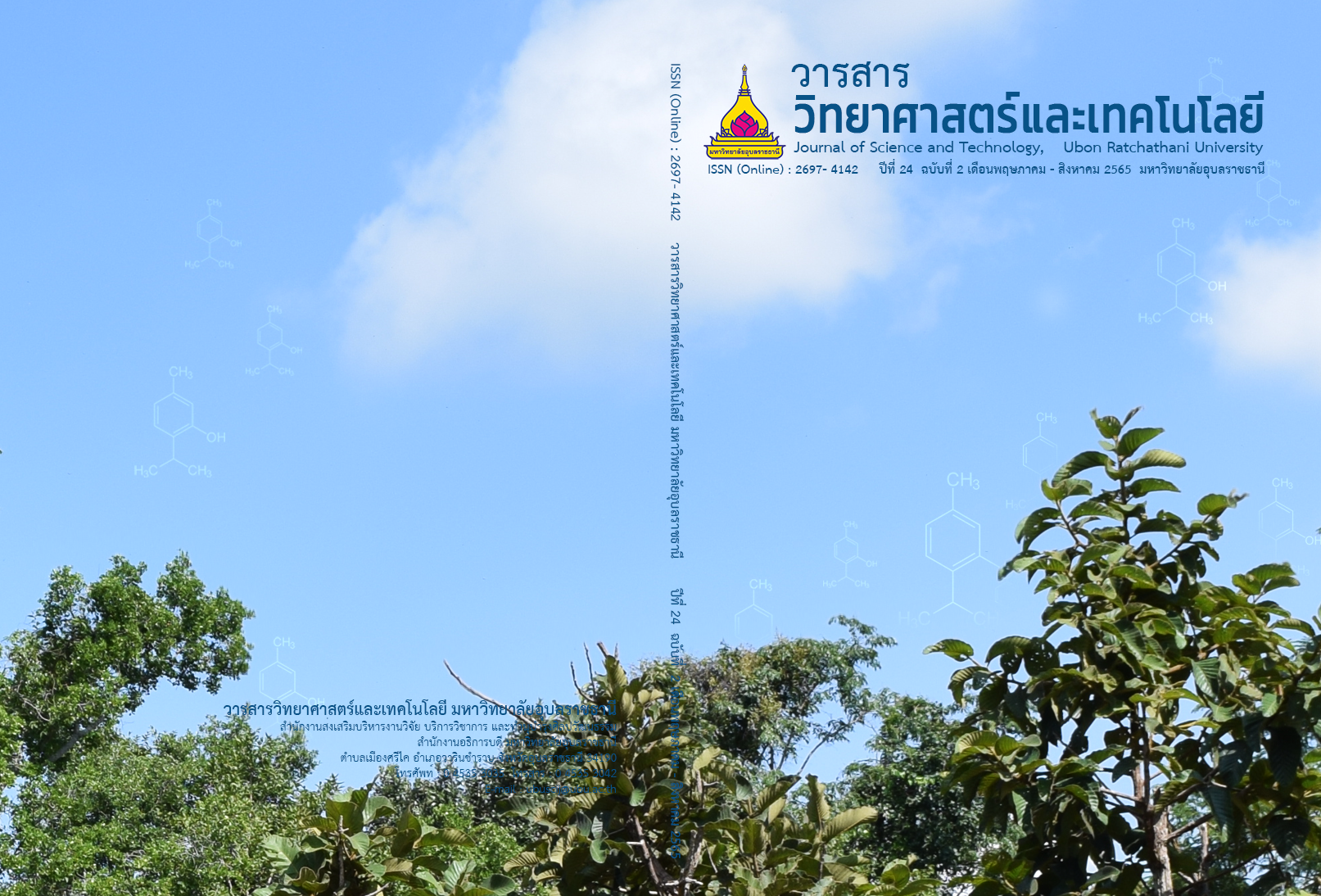สมบัติทางเคมีกายภาพและฤทธิ์ต้านอนุมูลอิสระของแป้งมันม่วงญี่ปุ่น ที่ผ่านการดัดแปรด้วยกรดและความร้อน
Main Article Content
บทคัดย่อ
แป้งที่ผลิตจากมันเทศนิยมนำมาใช้ในอุตสาหกรรมอาหาร การดัดแปรมันเทศที่จะนำมาใช้ทำแป้งสามารถทำให้สมบัติบางประการของแป้งดีขึ้น ซึ่งสามารถทำได้โดยการดัดแปรทางเคมี และการดัดแปรทางกายภาพ งานวิจัยนี้มีวัตถุประสงค์เพื่อศึกษา ผลของการดัดแปรมันม่วงญี่ปุ่นในกระบวนการผลิตแป้งมันม่วงญี่ปุ่นต่อสมบัติทางเคมีและทางกายภาพ รวมทั้งฤทธิ์ต้านอนุมูลอิสระของแป้งมันม่วงญี่ปุ่น ในการศึกษานี้เตรียมแป้งมันม่วงญี่ปุ่น 4 สูตร คือ S1, S2, S3 และ S4 โดย สูตร S1 เป็นสูตรควบคุมที่ไม่มีการดัดแปร สูตร S2 เป็นแป้งที่เตรียมจากมันม่วงญี่ปุ่นที่มีการดัดแปรด้วยกรดซิตริก และการให้ความร้อนโดยการลวก ส่วนสูตร S3 และ S4 เป็นแป้งที่เตรียมจากมันม่วงญี่ปุ่นที่มีการดัดแปรด้วยกรดซิตริก และการให้ความร้อนโดยการนึ่ง เป็นเวลา 30 และ 40 นาที ตามลำดับ จากนั้นนำแป้งมันม่วงญี่ปุ่นทุกสูตรไปวิเคราะห์สมบัติทางเคมี สมบัติทางกายภาพ และฤทธิ์ต้านอนุมูลอิสระ ผลการทดลองที่ได้พบว่าแป้งมันม่วงญี่ปุ่นสูตร S4 มีปริมาณฟีนอลิก ฟลาโวนอยด์ และแอนโทไซยานินมากที่สุด ซึ่งส่งผลให้มีสีม่วงที่เข้มที่สุด และมีฤทธิ์ต้านอนุมูลอิสระสูงที่สุด นอกจากนี้จากการวิเคราะห์ความหนืดพบว่าถึงแม้ค่าความหนืดสูงสุดของแป้งมันม่วงญี่ปุ่นทั้ง 4 สูตรไม่แตกต่างกันอย่างมีนัยสำคัญ แต่แป้งมันม่วงญี่ปุ่นสูตร S4 มีค่า breakdown และค่า setback ที่ต่ำที่สุด ซึ่งบ่งชี้ว่ามีความเสถียรมากที่สุด ผลที่ได้จากการวิจัยนี้เป็นข้อมูลเบื้องต้นที่มีประโยชน์ต่อกระบวนการผลิตแป้งมันม่วงญี่ปุ่นเพื่อให้ได้แป้งมันม่วงญี่ปุ่นที่มีสมบัติตามที่ต้องการ
Article Details

อนุญาตภายใต้เงื่อนไข Creative Commons Attribution-NonCommercial-NoDerivatives 4.0 International License.
บทความที่ได้รับการตีพิมพ์เป็นลิขสิทธิ์ของ วารสารวิทยาศาสตร์และเทคโนโลยี มหาวิทยาลัยอุบลราชธานี
ข้อความที่ปรากฏในบทความแต่ละเรื่องในวารสารวิชาการเล่มนี้เป็นความคิดเห็นส่วนตัวของผู้เขียนแต่ละท่านไม่เกี่ยวข้องกับมหาวิทยาลัยอุบลราชธานี และคณาจารย์ท่านอื่นๆในมหาวิทยาลัยฯ แต่อย่างใด ความรับผิดชอบองค์ประกอบทั้งหมดของบทความแต่ละเรื่องเป็นของผู้เขียนแต่ละท่าน หากมีความผิดพลาดใดๆ ผู้เขียนแต่ละท่านจะรับผิดชอบบทความของตนเองแต่ผู้เดียว
เอกสารอ้างอิง
Jubril, I., Muazu, J. and Mohammed, G.T. 2012. Effects of phosphate modified and pregelatinized sweet potato starches on disintegrant property of paracetamol tablet formulations. Journal of Applied Pharmaceutical Science. 2(2): 32-36.
Yadav, B.S., Guleria, P. and Yadav, R.B. 2013. Hydrothermal modification of Indian water chestnut starch: Influence of heat-moisture treatment and annealing on the physiochemical, gelatinization and pasting characteristics. LWT-Food Science and Technology. 53: 211-217.
Liao, L. and et al. 2019. Structural properties of sweet potato starch and its vermicelli quality as affected by heat-moisture treatment. International Journal of Food Properties. 22(1): 1122-1133.
Ye, F., Li, J. and Zhao, G. 2020. Physicochemical properties of different-sized fractions of sweet potato starch and their contributions to the quality of sweet potato starch. Food Hydrocolloids. 108: 106023.
Włodarczyk, S.M., Mazureka, A. and Jamroza, J. 2019. Physicochemical properties and structure of hydrothermally modified Starches. Journal of Food Science and Biotechnology. 95: 88-97.
Julino, B.O. and et al. 1981. International cooperative testing on the amylose content of milled rice. Starch. 33(5): 157-162.
AOAC. 2000. Official Method of Analysis of AOAC International. 17th edition, the Association Official Analytical Chemists. Gaithersburg, MD: AOAC International.
Thaipong, K. and et al. 2006. Comparison of DPPH, FRAP, and ORAC assays for estimating antioxidant activity from guava fruit extracts. Journal of Food Composition and Analysis. 19(7): 669-675.
Wanyo, P., Meeso, N. and Siriamornpun, S. 2014. Effects of different treatments on the antioxidant properties and phenolic compounds of rice bran and rice husk. Food Chemistry. 63 (157): 457-463.
Wiriyawattana P., Suwonsichon S. and Suwonsichon T. 2018. Effects of drum drying on physical and antioxidant properties of riceberry flour. Agriculture and Natural Resources. 52(5): 445-450.
Wicaksono, L.A., Yunianta, Y. and Widyaningsih, T.D. 2016. Anthocyanin extraction from purple sweet potato cultivar antin-3 (Ipomoea batalas L.) using maceration, microwave assisted extraction, ultrasonic assisted extraction and their application as anti-hyperglycemic agents in alloxan-induced wistar Rat. International Journal of PharmTech Research. 9(3): 181-192.
Xu, J. and et al. 2015. Characterisation and stability of anthocyanins in purple-fleshed sweet potato P40. Food Chemistry. 186: 90-96.
Montilla, C.V. and et al. 2010. Prearative isolation of anthocyanins from Japanese purple sweet potato. (Ipomoea batalas L.) varieties by high-speed countercurrent chromatography. Journal of Agricultural and Food Chemistry. 58: 9899-9904.
Li, C. and et al. 2011. Effect of processing on taste quality and health-relevant functionality of sweet potato tips. Agricultural Sciences in China. 10(3): 456-462.
Miskeen, S. and et al. 2021. Frabrication of citric acid-modified starch nanoparticles to improve their thermal stability and hydrophobicity. Carbohydrate Polymers. 253: 117242.
Curayag, Q.A.L., Dizon, E.I. and Hurtada, W.A. 2019. Antioxidant activity, chemical and nutritional properties of raw and processed purple-fleshed sweet potato (Ipomoea batatas Lam.) Cogent Food & Agriculture. 5: 1662930.
Praphala, N., Thonggnam, K., and Punnongwa, W. 2021. Effect of pregelatinize on physical properties of Japanese puple sweet potato starch. Agriculture and Technology Journal. 2(2): 95-109. (in Thai)


